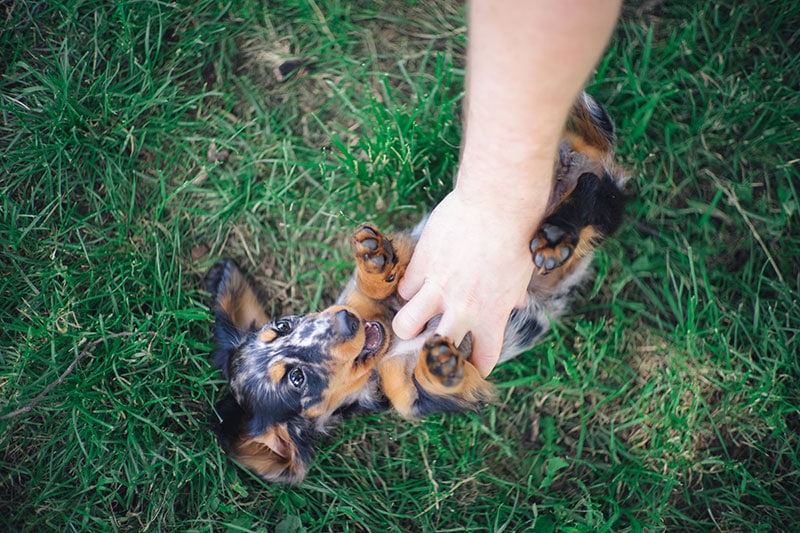We all know the hilarious yet tormented feeling of being tickled. And while we spend a good chunk of time rubbing our pet’s bellies, we can only wonder: are dogs ticklish? You’re not the first person to ask this question. In fact, some people swear they have seen their dogs laugh because of it, and Charles Darwin even got the ball rolling with this research topic.1 So, are dogs ticklish? Yes, but not in the same way we experience it.

Defining Tickling
It’s essential to define the obvious yet elusive question of what laughing is first since being tickled is followed by uncontrollable laughter. Merriam-Webster defines tickling as a response to “…excite the surface nerves and cause uneasiness, laughter, or spasmodic movements.” Scientists call this light touch knismesis. It describes the physical sensation you feel and might equate with goosebumps and that singular chill up your spine.
You may associate tickling with its other term, gargalesis. It is knismesis on steroids, where you’re laughing hysterically from the feeling. Knismesis suggests something instinctive, whereas gargalesis seems like something altogether different. The difference is essential since it clarifies the various feelings and emotions.

What Dogs Feel
To put tickling in perspective, it’s helpful to discern what canines can experience and how it fits into this context. Researchers estimate a dog’s emotional repertoire is similar to a 2.5-year-old child. That means they are capable of feeling the following emotions:
- Excitement
- Distress
- Contentment
- Disgust
- Fear
- Anger
- Joy
- Shyness
- Love
These feelings show they are capable of experiencing something akin to tickling and laughter. It’s worth noting that these emotions are both polarized and overwhelmingly positive. The chances are you associate laughing with happy times instead of stressful moments. However, the emotional capacity of canines doesn’t end there.
Canine Responses
Scientists have discovered a broad spectrum of responses. Dogs can distinguish between positive and negative emotions. One study showed that dogs could interpret our emotions bimodally or in two ways. That is evidence for higher processing. Nevertheless, our pets have learned a thing or two from cohabitating with us for so many centuries.

A Dog’s Laugh
Tickling involves laughing. Scientists have documented what seems like a truly canine response to tickling. It’s not the belly roar we express. Instead, it’s easy to mistake for panting and easy to discern once you know what to listen for when you tickle your pet. The research also revealed a positive response in puppies that would presumably show an instinctive reaction upon hearing it.
Of course, dogs vary in how ticklish they are and how sensitive different body parts are to this action. Some places sure to elicit a response include the neck, sides, and ears. The Caroline Springs Veterinary Hospital also suggests canines have sensitive paws. That may explain why some pets balk when you try to trim their nails. It tickles!
The Scratch Reflex
The response that probably has most dog owners questioning if their pets are ticklish is the so-called scratch reflex. You know the drill: you rub your pup’s belly and their legs start moving. You may think you’re hitting your dog’s sweet spot or are tickling them. Science has a different, albeit less amusing, explanation: it’s an instinctive reaction to some kind of environmental irritation.
Think of a bug crawling up your leg and your automatic response. You swipe at the unknown cause to get it off of you before it could bite you. Your dog is doing the same thing when you scratch their belly. English neurophysiologist Sir Charles Sherrington described this behavior over 100 years ago. He identified four stages to the response that included the following:
- The Latency Period
- The Warm-up
- The After Charge
- Fatigue

Organisms have two means of responding to stimuli. Tonic reception is continual awareness of the sensation. Pain is the classic example. Other senses, like olfaction, are phasic. Your body immediately recognizes it, categorizes it, and dismisses it if it’s not a threat. The scratch reflex in canines resembles this pattern if it goes to fatigue.

Conclusion
Research has shown that dogs can experience tickling even if it isn’t the same feeling we have. Our pets can respond to the sensation. They may also laugh if their bodies interpret it this way. The scratch reflex seems similar but is a different response. Tickling and laughing may imply an emotional action, whereas the latter is more instinctive despite the wiggling and shaking our dogs may display.
Featured Image Credit: aminahus, Shutterstock


















